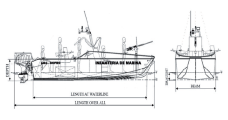Diseño y validación por el método de elementos finitos del arreglo estructural de un bote de combate fluvial de bajo calado
DOI:
https://doi.org/10.25043/19098642.218Palabras clave:
Escantillonado, análisis directo, cascos en aluminio, botes de combate de ríoResumen
En la navegación fluvial, las bajas profundidades, objetos parcialmente sumergidos y la presencia de vegetación representan restricciones para las labores de patrullaje y reconocimiento de la Armada Nacional. Por tal motivo, surge la necesidad de contar con una embarcación con capacidad de operar con un calado mínimo de 0.4 metros y que su arreglo estructural esté diseñado acorde con las recomendaciones de las sociedades clasificadoras y las necesidades operacionales de la Armada nacional. En el presente trabajo se detalla el escantillonado de un casco en aluminio con 8.6 metros de eslora total, 2.6 metros de manga y 0.35 metros de calado cuyo diseño permite una velocidad de 20 nudos, y un desplazamiento de 3.8 toneladas. Se siguió las recomendaciones establecidas por las sociedades clasificadoras y se realizó una posterior validación y mejoramiento del arreglo estructural por el Método de Elementos Finitos.
Descargas
Referencias bibliográficas
F. ALVAREZ Y M. L. MEDINA, Guerra Fluvial Irregular: Fuerzas de Combate en los Rios de América, Madrid: IDS. Navantia, 2012.
COTECMAR, «BCFBC. Manual de Usario,» Cartagena de Indias, 2020.
A. B. o. S. ABS, Rules for building and classing. High-Speed craft. Part 3: Hull Construction and Equipment, Houston, TX. USA: ABS, 2020.
International Organization for Standarization, Small Craft - Hull construction and Scantlings - Part 5: Design pressures for monohulls, design stresses, scantlings determinaion, ISO, 2014.
Det Norske Veritas Germanischer Lloyd´s DNV-GL, DNV-GL-CG-027- Class Guideline- Finite Element Analysis, 2015.
B. YONG Y J. WEI-LIANG , «Chapter 8 - Scantling of Ship's Hulls by Rule,» de Marine Structural Design, Butterworth-Heinemann, 2016, pp. 153-170. https://doi.org/10.1016/B978-0-08-099997-5.00008-3
K. ANYFANTIS, «Ultimate strength of stiffened panels subjected to non-uniform thrust,» International Journal of Naval Architecture and Ocean Engineering, vol. 12, pp. 325-342, 2020. https://doi.org/10.1016/j.ijnaoe.2020.03.003
D. VAN TUYEN , B. LIU, Y. GARBATOV, W. WU Y C. GUEDES SOARES, «Strength assessment of aluminium and steel stiffened panels with openings on longitudinal girders,» Ocean Engineering, vol. 200, 2020. https://doi.org/10.1016/j.oceaneng.2020.107047
J. K. PAIK, «Characteristics of welding induced initial deflections in welded aluminum plates,» Thin-walled Structures, vol. 45, pp. 493-501, 2007. https://doi.org/10.1016/j.tws.2007.04.009
Ship Structure Committe, SSC-218 Design Considerations for Alluminum Hull Structures, Washington D.C: Ship Structure Committe, 1971.
R. SIELSKI, «Research needs in aluminum structure,» Ships and Offshore Structures, vol. 3, pp. 57-65, 2008. https://doi.org/10.1080/17445300701797111
N. NAZEMI, F. GHRIB Y J. SOKOLOWSKI, «The HAZ in Aluminum Welding Revisited,» 3rd Specialty Conference on Engineering Mechanics and Materials, 2013.
J. PAIK, J. LEE, M. RYU, Y. JANG, H. RENAUD Y P. HESS, «Mechanical buckling collapse testing on Aluminium stiffened plate structures for marine applications,» The World Maritime Technology Conference, 2006.
M. COLLETTE, «Strength and Reliability of Aluminium Stiffened Panels,» Ph.D submission School of Marine Science and Technology, Faculty of Science, Agriculture and Engineering, University of Newcastle, 2005.
B. CHEN Y C. GUEDES SOAREs, «A Simplified Model for the Effect of Weld-Induced Residual Stresses on the Axial Ultimate Strength of Stiffened Plates,» Journal of Marine Science and Application, vol. 17, pp. 57-67, 2018. https://doi.org/10.1007/s11804-018-0007-7
P. HERRINGTON Y R. LATORRE, «Development of an aluminum hull panel for high-speed craft,» Marine Structures, vol. 11, pp. 41-71, 1998. https://doi.org/10.1016/S0951-8339(97)00008-7
B. LIU, R. VILLAVICENCIO Y G. S. SOARES, «On the failure criterion of lowvelocity impact by a spherical indenter,» International Journal of Mechanical Sciences, vol. 80, pp. 1-15, 2014. https://doi.org/10.1016/j.ijmecsci.2013.12.015
B. LIU, S. WANG, R. VILLAVICENCIO Y C. GUEDES SOARES, «Slamming load and hydroelastic structural reponse og bow flare areas of aluminium fast displacement crafts,» Ocean Engineering, 2020. https://doi.org/10.1016/j.oceaneng.2020.108207
B. YONG Y J. WEI- LIANG, «Chapter 8: Ship Hull Scantling Design by Analysis,» de Marine structural design, 2016, pp. 171-180. https://doi.org/10.1016/B978-0-08-099997-5.00009-5
American Bureau of Shipping, Guidance notes on Structural Direct Analysis for High-Speed Craft, Houston: ABS, 2018.
Lloyd´s Register, Rules for the manufacture, testing and certifications of materials, London: Lloyd's Register Group, July 2020.
COTECMAR, «Cálculos de Escantillonado del Bote de Combate Fluvial de Bajo Calado - BCFBC,» Cartagena de Indias, 2020.
E. NIEME, W. FRIKLE Y S. MADDOX, «Structural Hot- spot Stress Determination Using Finite Element Analysis,» de Structural Hot-Spot Stress Approach to Fatigue Analysis of Welded Components, IIW Collection, 2018. https://doi.org/10.1007/978-981-10-5568-3
Lloyd´s Register, Rules and regulations for the classification of special service craft, London, July 2020.

Descargas
Publicado
Cómo citar
Número
Sección
Licencia
The authors who publish in this Journal certify that:
- The work submitted for publication in The Ship Science and Technology journal, was written by the author, given that its content is the product of his/her direct intellectual contribution.
- All data and references to material already published are duly identified with their respective credits and are included in the bibliographic notes and quotations highlighted as such.
- All materials submitted for publication are completely free of copyrights; consequently, the author accepts responsibility for any lawsuit or claim related with Intellectual Property Rights thereof, Exonerating of responsibility to The Science and Technology for the Development of Naval, Maritime, and Riverine Industry Corporation, COTECMAR.
- In the event that the article is chosen for publication by The Ship Science and Technology journal, the author state that he/she totally transfers reproduction rights of such to The Science and Technology for the Development of Naval, Maritime, and Riverine Industry Corporation, COTECMAR.
- The authors retain the copyright and transfer to COTECMAR the right of publication and reproduction of the work which will be simultaneously subject to the Creative Commons Attribution License (CC - BY), which allows the license to copy, distribute, display and represent the work and to make derivative works as long as it recognizes and cites the work in the manner specified by the author or licensor.
- For more information about the Creative Commons Attribution License (CC -BY) and his use and scope, please visit the following web page https://creativecommons.org/licenses/by-sa/4.0/legalcode








